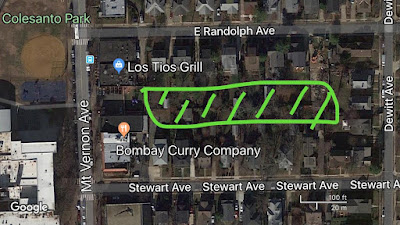This is a project that I dreamed up during my TreeSteward training in 2008. I never got the chance to implement it because in 2012 we got transferred to Rome, and then Uruguay, and then Kosovo. Well, ten years later, I’ve just returned home. My garden is a complete shambles. Most of the native plants are gone, replaced by the invasive bush honeysuckle and English ivy that surround my yard. I’ve spent the end of fall and most of the spring beating it back, and planning the new design for my native plant garden.
I never forgot about this Back Block Biome project, and little by little I’m co-opting the neighbors in my block to join me in creating a native plant oasis in the growing city where we live. This is more important than ever, since our neighborhood is quickly giving way to infill development, cottage tear downs that are replaced with massive mansions, only after removing every tree, shrub and blade of grass from the lots. So here, mostly to inspire myself to implement my project, I post here the plan. I’ll update the post with how successful I’ve been.
The Back Block Biome Project
The effects and success of gardening for biodiversity can be increased by joining with your neighbors to plant a variety of native plants, shrubs and trees to create a larger area for insects, birds and pollinators to inhabit. I've found that when I'm outside planting and maintaining my garden, my neighbors stop by and talk about what I'm up to. When they see the bees, birds and butterflies enjoying my tiny habitat, they're often inspired to try planting native plants as well.
Many of us live in urban or suburban neighborhoods where we have adjoining back yards in our block. A lot of people think that native plants are rangey, scrubby, leggy or pushy. Sometimes they do spread out because they are so well suited to their native habitat, and also because sustainable gardening techniques don't advise using herbicides and pesticides, and so plants tend to thrive. Because of this opinion that some native plants are misbehaved, I advise people to relegate some large native perennials like Joe Pye Weed to the back corner of their yard. This made me realize that if everyone in a backyard block did this, we would have an impressive contiguous area of habitat. Nobody has enough room or money to plant host plants and nectar plants for every pollinator in our area. But we can collaborate to provide habitat for the butterflies, bees, birds and bunnies that we all want to support and enjoy.
I imagined holding a Back Block Biome party at my house, to explain my idea and share a list of plants and techniques to create an interconnected native wildlife habitat.
Here is what I mean for a Back Block Biome.
For illustration purposes, I searched on Google Maps and chose a block behind the school where I used to teach. It's suburban/commercial, with single family houses and a couple of restaurants in the block. There's also a park and a library next to the school yard. I thought it might be cool to invite the restaurants, school and library to get involved in the project as well as a community support project. I marked in green the adjoining backyard area where native plants could be planted so birds and butterflies could benefit from a larger habitat area than if just one family did wildlife gardening.
I've learned that native habitat gardening is contagious. Once neighbors see you enjoying your yard full of lovely plants that attract butterflies and birds, they will be interested in joining in. If you live in an area with adjoining yards, consider organizing a planting project. You'll get to know your neighbors better and help wildlife as well.
When I taught at the school in this picture, we did an annual planting and clean up day. Teachers and parents worked together to make the school a nice inviting place. After everyone worked together, we had a good feeling of belonging to a community.
I hope you like this idea and give it a try. Use the links on the sidebar of this blog to get started on how to choose plants for butterflies and other wildlife. Hold a meeting or a party and share the information with your neighbords to create your Back Block Biome. Have fun and let me know how it goes.
